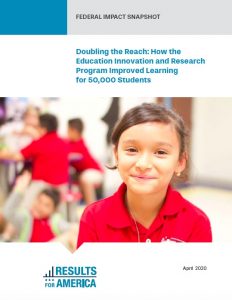 Improving K-12 education is vital to our nation’s economic mobility and social well-being. Nationally, only 34% of 8th grade students are proficient in reading, math, and science, while 15% of students fail to graduate high school on time.
Improving K-12 education is vital to our nation’s economic mobility and social well-being. Nationally, only 34% of 8th grade students are proficient in reading, math, and science, while 15% of students fail to graduate high school on time.
The numbers are even lower for students of color. Only 22% of Latino and 15% of African-American 8th grade students are proficient in reading, with slightly lower proficiency rates in math and science. The high school graduation rate for African-American and Latino students mirrors this trend, with approximately 20% failing to graduate on time.
Luckily, a growing number of local, state, and federal government agencies are investing taxpayer dollars in evidence-based solutions. According to Results for America’s 2019 Invest in What Works Standard of Excellence, 35 of the largest federal social services programs – including the U.S. Department of Education’s (ED) Education and Innovation Research (EIR) program and the Replication and Expansion of High-Quality Charter Schools program – prioritized evidence of effectiveness in some way when allocating grant dollars.
An increasing number of elementary and secondary schools are using federal funds like these to implement evidence-based approaches. Since 2010, EIR (and its predecessor, the Investing in Innovation (i3) program) has shifted more than $1.95 billion dollars toward what works in education. For example, a $50 million Scale-up grant in Fiscal Year (FY) 10 made it possible for KIPP public charter schools, which are organized around an evidence-based model, to double the number of students it served, from 28,000 in 2010 to over 80,000 in 2016.
This evidence of impact and success positioned KIPP to successfully win over $218 million from 2010-2018 from ED’s Replication and Expansion of High-Quality Charter Schools program, which helps charter school management organizations open or expand one or more high-quality charter schools.
The Impact Snapshot below tells the story of how the evidence definitions and tiered-evidence funding framework within the federal grant programs described above helped improve student outcomes by shifting increasing amounts of federal taxpayer funds toward evidence-based solutions like KIPP’s.